Conservation of Endangered Species
Yangtze River Fisheries Research Institute, Chinese Academy of Fishery Sciences
Field
Research-fields
1. Artificial propagation and enhancement of Chinese sturgeon
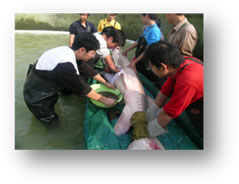
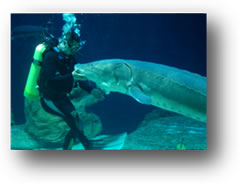
Induced spawning Postpartum Recovery
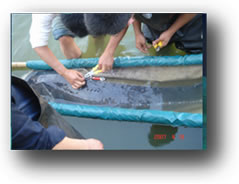

Install ultrasonic mark Artificial enhancement

Fixed station of VemcoVR2(W) distributed in Yangtze River
2. Morphology hypothesis for spawning areas of Chinese sturgeon
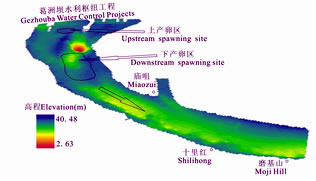 Topography and main spawning areas of Chinese sturgeon
Topography and main spawning areas of Chinese sturgeon
(before Regime adjustment engineering)
Selected publication:
Hui Zhang, Qiwei Wei, Hao Du. A bedform morphology hypothesis for spawning areas of Chinese sturgeon. Environ Biol Fish. 2009,84:199-208
3. Underwater video reveals spawning bed quality of Chinese sturgeon

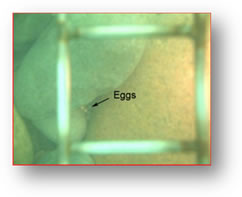
Photos of underwater video of Chinese sturgeon eggs adhere at the river pebble
Selected Publication:
H. Du, Q.W.Wei, H.Zhang, et.al. Bottom substrate attributes relative to bedform morphology of spawning site of Chinese sturgeon Acipenser sinensis below the Gezhouba dam. J. Appl. Ichthyol. 2011,(27), 257–262
4. Synthetic chemicals increase the rates of malformation of larvae of Chinese sturgeon
Our group collaborate with Urban and Environmental college of Peking University
found that sturgeon deformities may be associated with tin compounds-Triphenyltin(TPT)


Malformations of 18 d posthatch wild Chinese sturgeon larve
Publication:
Jianying Hu, Zhaobin Zhang, Qiwei Wei. et,al. Malformations of the endangered Chinese sturgeon, Acipenser sinensis, and its causal agent. PNAS. 2009(106):9339-9344.
5. Collaborative study of swimming behavior in relation to buoyancy of Chinesen Sturgeon
The swimbladder of fishes is readily compressed by hydrostatic pressure
with depth, causing changes in buoyancy. While modern fishes can regulate
buoyancy by secreting gases from the blood into the swimbladder, primitive fishes,
such as sturgeons, lack this secretion mechanism and rely entirely on air gulped at the
surface to inflate the swimbladder. Therefore, the cyclical behavior of rise out of
natural water to swallowing air of Chinese sturgeon, that’s may the main reason
which contributed to their vulnerability to be damaged by ships.
Publication:
Y.Watanabe, Q.Wei, D.Yang. et,al. Swinning behavior in relation to buoyancy in an open swimbladder fish, the Chinese sturgeon. Journal of Zoology.2008(275):381-390.
6. Experimental detection of Psephurus gladius
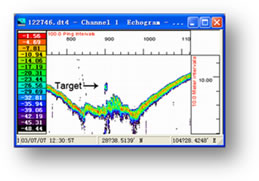

Echograms of two most potential targets of Psephurus gladius
Four large-range hydroacoustic surveys (using an echo sounder with a 199kHz, 6.8°split-beam transducer)
and capture surveys(by drift nets and setlines) were conducted in the upper Yangtze River during 2006-2008. .
Publication:
H.Zhang, Q.W.Wei, H. Du. et,al. Is there evidence that the Chinese paddlefish (Psephurus gladius)still survives in the upper Yangtze River? Concerns inferred from hydroacoustic and capture surveys, 2006-2008. J.Appl.Ichthyol. 2009,25(Suppl.2):95-99.
7. Gymnocypris przwalskii resources evaluation
Every summer, our group will send 1-2 people to Qinghai Lake to assist local fishery research institutes to study on stocks, densities, population, and individual of G. przwalskii by using hydroacoustics technology(BioSonincs DT-X and EY 60 echo-sounders), and to provide the basis for the protection and utilization of G. przwalskii stocks.
8. Artificial propagation and Habitat survey of Qinling lenok (Brachymystax lenok tsinlingensis)
 Development stage of Brachymystax lenok tsinlingensis embryo
Development stage of Brachymystax lenok tsinlingensis embryo
1: zygote; 2:1-cell stag;3:2-cell stage; 4:4-cell stage; 5:8-cell stage;6: 16-cell stage; 7:32-cell stage; 8: 64-cell stage; 9: Muhicellular stage; 10:Early-blastula stage; 11:Mid-blastula stage; 12:Late-blastula stage; 13:Early-gastrula stage; 14: Mid-gastrula stage; 15:Late-gastrula stage; 16:Neurula plate stage(arrowhead: Blastopore); 17:Blastopore closed stage; 18:Eye anlage stage; 19:Brain differentiation stage; 20:Pectoral fin anlage stage; 21:Eye vesicle stage; 22:Tail bud formed stage; 23:Rudiment of pectoral fin stage: 24:Eye lens formed stage; 25:Caudal fin appearance; 26:Eye pigment stage; 27:Hatching.
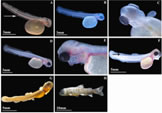 Development of Brachymystax lenok tsinlingensis larvae and juveniles
Development of Brachymystax lenok tsinlingensis larvae and juveniles
A. hatching larvae(arrowhead: anal tubercle); B. 3 d larvae after hatching; C. 3 d larvae after hatching(enlarged: melanin); D. 5 d larvae after hatching; E.5d larvae after hatching(enlarged: melanin); F.7d larvae after hatching(arrowhead: Rudiment of adipose fin); G. 12d larvae after hatching; H. 46 d larvae after hatching
9. Resource enhancement and marking releasing of rare fish in Yangtze River
Main marking types:
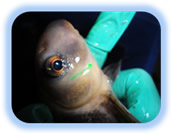
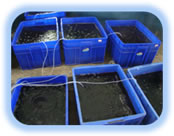

VIE fluorescent mark Otolith mark Plugin mark

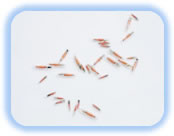

Anchor mark PIT mark Sonar Mark
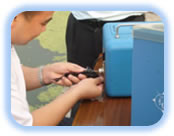
CWT mark

